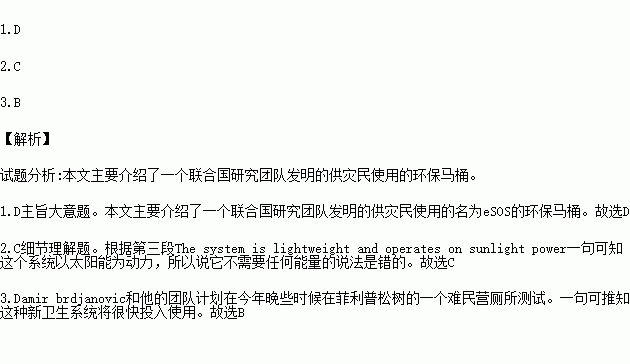题目内容
War or natural disasters often destroy or cause major damage to sanitary systems. The destruction of waste treatment systems can increase the risk of disease and even death among survivors.
Some people dig holes in the ground that serve as individual toilets. However, micro-organisms from human wastes can reach water supplies and cause cholera or other diseases.
A United Nations team is now developing a toilet for disaster areas. The experimental project is called eSOS—for the Emergency Sanitation Operation System. The system is lightweight and operates on sunlight power.
Scientists are working on the toilet at the UN’s Institute for Water Education in the Netherlands. Damir Brdjanovic is heading the project. He says his team hopes to bring disaster assistance into the 21st century.
The eSOS system has several ‘smart’ features, such as a self-contained energy supply unit. Another is a global positioning system sensor, very much like the GPS equipment in some vehicles. There is also equipment that measures waste buildup. All of the information from the toilet system can be shared with an emergency organization center. Officials at the center can then identify the needs of an affected disaster area. The eSOS system can also recycle liquid wastes into water that can be used for farming. This involves treating the urine(尿液)with the help of a membrane bioreactor system(膜生物反应器系统).
The smart toilet is being tested. Damir Brdjanovic and his team plan to test the toilet at a refugee camp in the Philippines later this year. The developers hope this disaster relief will save the lives of many refugees.

1.What’s the best title of the passage?
A. Toilet for Our Future Life
B. Machine to Recycle Human Wastese
C. New Technology to Reduce the Risk of Disease
D. SOS—the Emergency Sanitation Operation System
2.Which of the following is NOT true about eSOS?
A. It weighs light.
B. It serves as individual toilet for disaster survivors.
C. It doesn’t need any power.
D. It is equipped with a global positioning system sensor.
3.What can we infer from this passage?
A. eSOS can prevent any risk of disease.
B. eSOS will be put into use in the near future.
C. Damir Brdjanovic holds a negative attitude to eSOS.
D. The eSOS system can recycle liquid wastes into drinkable water.
 口算题卡北京妇女儿童出版社系列答案
口算题卡北京妇女儿童出版社系列答案
